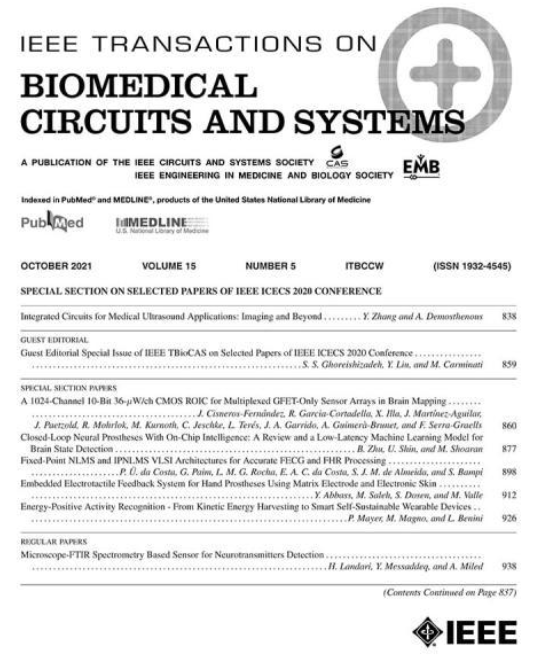点护理超声成像系统的片上系统解决方案:架构和ASIC实现
IF 4.9
2区 医学
Q2 ENGINEERING, BIOMEDICAL
IEEE Transactions on Biomedical Circuits and Systems
Pub Date : 2016-04-01
DOI:10.1109/TBCAS.2015.2431272
引用次数: 49
摘要
在本文中,我们提出了一种新的片上系统(SOC)解决方案,用于便携式超声成像系统(PUS)的护理点应用。PUS-SOC包括所有信号处理模块(即发射和动态接收波束形成模块,中端和后端处理器以及彩色多普勒处理器)以及基于硬件的成像方法的高效架构(例如,动态延迟计算,多波束形成和编码激励和压缩)。该PUS-SOC采用联华电子130纳米NAND工艺制造,计算能力为16.8 GFLOPS,总等效栅极数为1210万,与奔腾-4 CPU相当。PUS-SOC的尺寸为27×27 mm2,功耗为1.2 W。基于puss - soc,实现了一个手持式美国成像系统原型。幻影实验表明,puss - soc可以为即时护理应用提供适当的图像质量,具有紧凑的PDA尺寸(200×120×45 mm3)和3小时的电池寿命。本文章由计算机程序翻译,如有差异,请以英文原文为准。
A System-on-Chip Solution for Point-of-Care Ultrasound Imaging Systems: Architecture and ASIC Implementation
In this paper, we present a novel system-on-chip (SOC) solution for a portable ultrasound imaging system (PUS) for point-of-care applications. The PUS-SOC includes all of the signal processing modules (i.e., the transmit and dynamic receive beamformer modules, mid- and back-end processors, and color Doppler processors) as well as an efficient architecture for hardware-based imaging methods (e.g., dynamic delay calculation, multi-beamforming, and coded excitation and compression). The PUS-SOC was fabricated using a UMC 130-nm NAND process and has 16.8 GFLOPS of computing power with a total equivalent gate count of 12.1 million, which is comparable to a Pentium-4 CPU. The size and power consumption of the PUS-SOC are 27×27 mm2 and 1.2 W, respectively. Based on the PUS-SOC, a prototype hand-held US imaging system was implemented. Phantom experiments demonstrated that the PUS-SOC can provide appropriate image quality for point-of-care applications with a compact PDA size ( 200×120×45 mm3) and 3 hours of battery life.
求助全文
通过发布文献求助,成功后即可免费获取论文全文。
去求助
来源期刊

IEEE Transactions on Biomedical Circuits and Systems
工程技术-工程:电子与电气
CiteScore
10.00
自引率
13.70%
发文量
174
审稿时长
3 months
期刊介绍:
The IEEE Transactions on Biomedical Circuits and Systems addresses areas at the crossroads of Circuits and Systems and Life Sciences. The main emphasis is on microelectronic issues in a wide range of applications found in life sciences, physical sciences and engineering. The primary goal of the journal is to bridge the unique scientific and technical activities of the Circuits and Systems Society to a wide variety of related areas such as: • Bioelectronics • Implantable and wearable electronics like cochlear and retinal prosthesis, motor control, etc. • Biotechnology sensor circuits, integrated systems, and networks • Micropower imaging technology • BioMEMS • Lab-on-chip Bio-nanotechnology • Organic Semiconductors • Biomedical Engineering • Genomics and Proteomics • Neuromorphic Engineering • Smart sensors • Low power micro- and nanoelectronics • Mixed-mode system-on-chip • Wireless technology • Gene circuits and molecular circuits • System biology • Brain science and engineering: such as neuro-informatics, neural prosthesis, cognitive engineering, brain computer interface • Healthcare: information technology for biomedical, epidemiology, and other related life science applications. General, theoretical, and application-oriented papers in the abovementioned technical areas with a Circuits and Systems perspective are encouraged to publish in TBioCAS. Of special interest are biomedical-oriented papers with a Circuits and Systems angle.
 求助内容:
求助内容: 应助结果提醒方式:
应助结果提醒方式:


